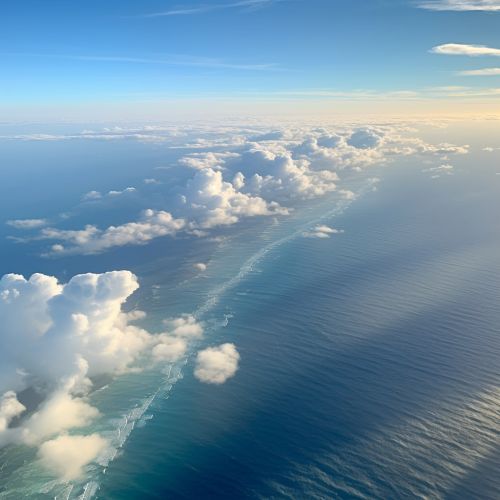Indian Ocean monsoon
Overview
The Indian Ocean monsoon is a significant weather phenomenon that affects the climate of many countries in the Indian Ocean region. It is characterized by a seasonal reversal of wind direction, typically accompanied by changes in precipitation. The monsoon is a complex system, influenced by a variety of factors, including the temperature of the ocean surface, the position of the ITCZ, and the topography of the land.


Causes and Mechanisms
The primary cause of the Indian Ocean monsoon is the differential heating of the land and the ocean. During the summer months, the landmass of the Indian subcontinent heats up more rapidly than the surrounding ocean, creating a low-pressure area over the land. This draws in moist air from the ocean, resulting in heavy rainfall. Conversely, in the winter months, the land cools down more rapidly than the ocean, creating a high-pressure area over the land and drawing in dry air from the ocean.
The Indian Ocean monsoon is also influenced by the position and movement of the ITCZ, a belt of low pressure near the equator where the trade winds of the Northern and Southern Hemispheres converge. The ITCZ shifts with the seasons, moving northward during the Northern Hemisphere summer and southward during the Northern Hemisphere winter. This movement of the ITCZ is a key factor in the timing and intensity of the monsoon.
Monsoon Seasons
The Indian Ocean monsoon has two distinct seasons: the Southwest Monsoon and the Northeast Monsoon. The Southwest Monsoon, also known as the Summer Monsoon, typically begins in late May or early June and lasts until September. During this period, the winds blow from the southwest, bringing heavy rainfall to the western coast of India and other countries in the region.
The Northeast Monsoon, also known as the Winter Monsoon, typically begins in October and lasts until early December. During this period, the winds blow from the northeast, bringing dry, cool air to the region. The Northeast Monsoon is less intense than the Southwest Monsoon, with less rainfall and milder temperatures.
Impact on Climate and Agriculture
The Indian Ocean monsoon has a profound impact on the climate and agriculture of the region. The heavy rainfall during the Southwest Monsoon replenishes water reservoirs and is crucial for the cultivation of crops such as rice, sugarcane, and cotton. The dry conditions during the Northeast Monsoon, on the other hand, are favorable for crops such as wheat and mustard.
However, the monsoon can also bring challenges. Excessive rainfall can lead to flooding and landslides, while insufficient rainfall can result in drought. Both scenarios can have devastating effects on agriculture and livelihoods.
Monsoon Prediction and Monitoring
Predicting the timing and intensity of the Indian Ocean monsoon is a complex task, involving the analysis of a variety of atmospheric and oceanic parameters. Several institutions, including the IMD, conduct regular monitoring and forecasting of the monsoon.
Advancements in satellite technology and numerical weather prediction models have improved the accuracy of monsoon forecasts in recent years. However, predicting the monsoon remains a challenging task due to the inherent variability and complexity of the system.
